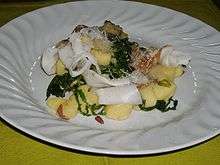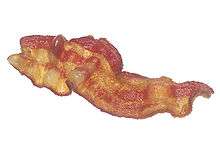Vallée d'Aoste Lard d'Arnad

Vallée d’Aoste Lard d’Arnad (PDO) is a cured pork product—specifically a species of lardo—produced exclusively within the municipal boundaries of the commune of Arnad in lower Aosta Valley, Italy. It was awarded European Union protected designation of origin (PDO) status in 1996 and is promoted by the “Comité pour la valorisation des produits typiques d'Arnad - Lo Doil” producers association.
The lardo, one of a number of preserved meat specialties of the region,[1][2] is produced by curing pieces of fatback in a brine aromatised with such herbs and spices as juniper, bay, nutmeg, sage and rosemary.[3] The brining takes place in wooden tubs known as doïls, which may be made of chestnut, oak or larch, and are used solely for this purpose; it is known that Lard d’Arnad has been made for more than two centuries since a 1763 inventory from Arnad Castle refers to four doïls which belonged to its kitchens.[4] It is often eaten with black bread and honey.[2]
The traditional Féhta dou lar (Arnad Francoprovençal patois for Lard Festival) is a Sagra held each year on the last Sunday of August. It has become a significant tourist attraction.
See also
 bacon portal
bacon portal
References
- ↑ Labourdette, Jean-Paul; Auzias, Dominique. Milan / Turin 2010 Petit Futé. Petit Futé. p. 268. ISBN 978-2-7469-2857-2.
- 1 2 Touring Club of Italy (2004). The Italian Wine Guide: The Definitive Guide to Touring, Sourcing, and Tasting. Touring Editore. p. 30. ISBN 978-88-365-3085-4.
- ↑ The specific herbs and spices listed here are from it:Lardo
- ↑ "Enogastronomia Valle d'Aosta/ Œnogastronomie Vallée d'Aoste" (PDF). Regione autonoma Valle d’Aosta / Région autonome Vallée d'Aoste. p. 4.
Other projects
![]() Media related to Lardo di Arnad at Wikimedia Commons
Media related to Lardo di Arnad at Wikimedia Commons
External links
- Vallée d’Aoste Lard d’Arnad - Aosta Valley official tourism board (multilingual)
- Vallée d'Aoste Lard d'Arnad (DOP), Italianmade.com (English)